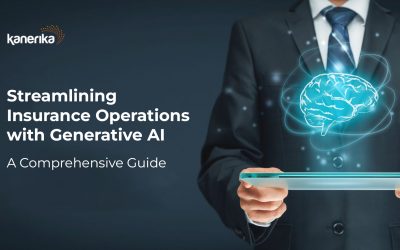The year is 1966. Eminent German-American computer scientist Joseph Weizenbaum proudly stands at a podium and announces his invention. The world’s first AI chatbot, ELIZA.
ELIZA’s purpose? It played the role of a psychotherapist and gave human-like responses to users. Therefore, convincing a majority of the population that it was more than just a computer. It almost felt like science-fiction.
Yet, here we are in 2024 – a pivotal year in the growth and popularity of artificial intelligence (AI), with generative AI (GenAI) models available at every individual’s fingertips.
While organizations such as Google and Meta have been working on developing AI technologies for more than a decade, OpenAI pulled ahead in the race and announced GPT-3 to the public. The effect was incredible – millions of people were able to use ChatGPT to create content, write code, and do research.
But generative AI use cases did not stop there. Businesses were quick to discover that, when used in a systematic process, GenAI can be extremely useful for a variety of business use cases. Here are some businesses that are already benefiting from GenAI:
Coca Cola
Coca-Cola is taking marketing to the next level by harnessing the power of generative AI. They’re merging the artistic flair of DALL.E with the conversational prowess of ChatGPT to create unforgettable consumer experiences. Just visualize their recent ad campaign—dubbed “Masterpiece”—where AI breathes life into iconic artworks, making them dance off the canvas. It’s not just marketing; it’s an immersive experience.
Mastercard
Mastercard is setting a new standard in customer service by integrating ChatGPT into their existing chatbot platform. But this isn’t your run-of-the-mill chatbot. It’s a virtual assistant that can handle a broad spectrum of customer needs. From checking account balances to diving deep into transaction histories. What sets it apart? Its ability to learn from consumer behavior. Thereafter, offering personalized recommendations that make it easier for users to analyze and make financial decisions.
Shopify
Shopify is making the lives of online store owners a breeze by incorporating ChatGPT into its Shop app. This isn’t just about answering customer queries; it’s a multi-faceted tool that assists in content creation. Store owners can now effortlessly craft SEO-optimized blogs, whip up engaging emails, and even generate compelling product descriptions, all with the help of generative AI.
McKinsey estimates that generative AI could inject between $2.6 trillion and $4.4 trillion of annual value into the global economy. For CIOs and CTOs, this is an opportunity for them to scale with the times and adapt their technological models to fully benefit from the GenAI wave.

Source: Google
After all, the evidence is there – big brands have utilized generative AI and benefited from it. It works. But how will it work for your organization? That’s where the challenge lies.
The challenge of implementing GenAI is twofold. In the long term, it’s about recognizing how you can implement GenAI and what you stand to gain from it. But in the immediate term, the hurdle is simply getting started.
Recognizing this need, our team got together to create this “Generative AI CTO Guide” for you and your organization to get started on your generative AI journey. Read ahead to explore the best practices and industry trends that can help you navigate your organization’s journey into the realm of GenAI.
Table of Contents
- Generative AI: Getting Started and Implementing
- How Generative AI Transforms the Daily Grind
- The Powerhouse of Generative AI: What Fuels the Tech
- Find Your Niche: Identifying the Perfect Domain for your Generative AI Needs
- Defining the Roles for Your Generative Models
- Data-Driven Success: Identifying Key Data Sources for Generative AI
- Assembling Your AI Dream Team: Who You Need on Board
- Charting the Course: Creating a Business Roadmap for Generative AI
- Maximizing Output: The Smart Way to Utilize Generative AI
- Speak Their Language: How Generative AI Engages Your Audience
- The Blueprint for Success: Mastering Language Model Operations
- The Journey Ahead: Why This is Just the Start in Generative AI
Generative AI: Getting Started and Implementing
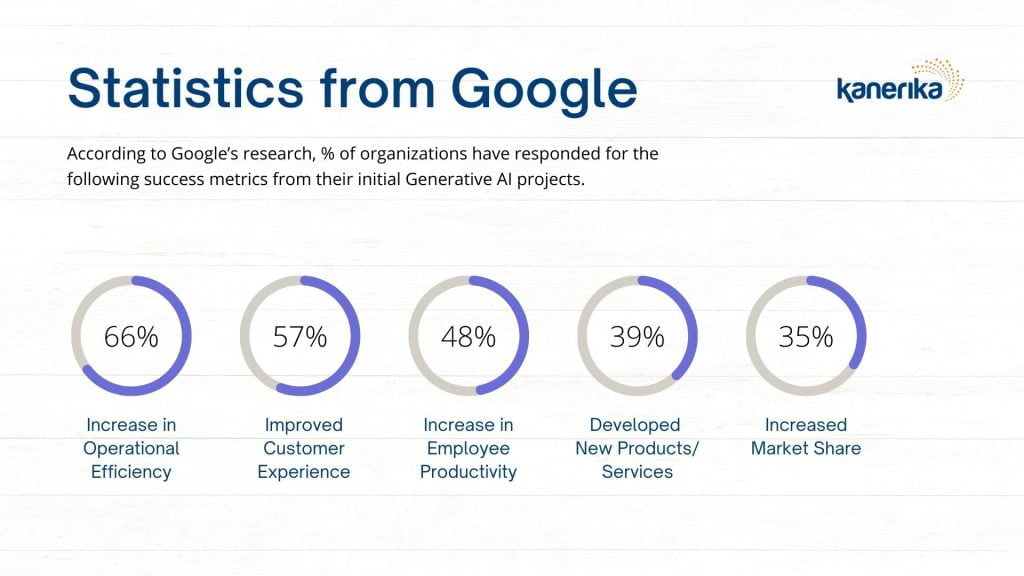
Before we get started, it is important to understand how the current market views generative AI (GenAI). The response is overwhelmingly positive.
According to Google’s research, 66% of organizations using GenAI reported increased operational efficiency, and an impressive 57% noted an improved customer experience. But that’s not all; nearly half of the organizations experienced accelerated innovation, and 48% saw a boost in employee productivity.
The success metrics of GenAI don’t stop there. About 39% of organizations developed new products or services using generative AI models, and 35% increased their market share. Furthermore, the same percentage, 35%, reported improved strategic decision-making. Interestingly, 12% even saw an uptick in shareholder or investor demand.
In the face of these incredible statistics, the question is a simple one – how is generative AI so successful?
How Generative AI Transforms the Daily Grind
Let’s face it – day-to-day business operations are not exactly exciting for employees. Individuals have to sift through mountains of data and analyze patterns within them to discover insights that can then guide the management team to make informed decisions.
Whether it’s analyzing the impact of ad spend on customer perceptions or tracking a competitor’s R&D investments, the quest for actionable insights is a never-ending task. And it’s not just a one-off endeavor; it’s an ongoing cycle that involves convening experts, conducting research, and compiling information. It’s a process that everyone, from executives to new hires, finds frustratingly time-consuming.
This is the key pain point that multiple industries have had to face.
Repetitive manual tasks eat into an employee’s time and productivity, drawing them away from focusing on more important tasks – such as strategy or execution.
Generative AI solves this problem rather easily, using the knowledge of vast Large-Language models (LLMs) and automation that together produce an AI bot that can answer queries, review data, and automate manual tasks with a single prompt.
With GenAI, everyone would be empowered to focus more on doing and less on waiting. This is where numerous businesses have capitalized on generative AI and used it to optimize their existing business processes while taking business decisions focused on automation and AI.
AI will rule the future, but how do we create that future for our organizations? Let’s take a deep dive into the process.
The Powerhouse of Generative AI: What Fuels the Tech
At their core, generative AI models are powered by foundational models, like Large Language Models (LLMs), trained on a plethora of content ranging from text and images to videos and medical information.
Unlike traditional software that relies on deterministic functions, these foundation models operate probabilistically. They analyze patterns and calculate the most likely outcomes, whether it’s answering a question or generating a caption for an image.
This makes them incredibly versatile, capable of performing a wide array of tasks like Q&A, summarization, and open-ended content generation without requiring additional data or tuning.
The upcoming section of our Generative AI CTO Guide will unveil a straightforward, 8-step roadmap designed to seamlessly integrate GenAI into your organization’s operations.
1. Find Your Niche: Identifying the Perfect Domain for your Generative AI Needs
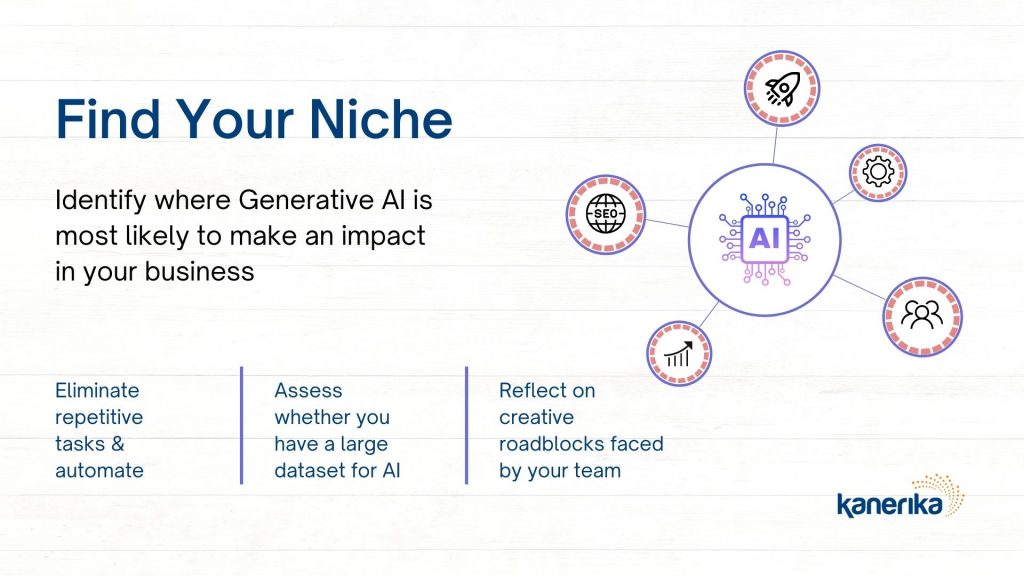
The first milestone on our Generative AI CTO guide is understanding your requirements for this technology. Where do you see the use of generative AI within your existing business processes?
This could be anything from customer service and patient intake to content marketing and data analysis. Based on your industry and service model, GenAI can seamlessly plug into your business model and amplify it, provided you identify your domain well.
To make this decision, consider several key questions.
- Think about the areas in your business where employees are stuck doing repetitive tasks.
- Identify processes or roles that are already standardized and could be ripe for automation.
- Reflect on the creative roadblocks that your team faces and the potential risks of incorrect AI-generated responses in different departments.
- Assess whether you have a large dataset that is currently underutilized and could be activated through AI.
- Finally, consider whether your employees often find themselves searching through internal or external databases to gather information.
Answering these questions will provide you with a comprehensive understanding of where generative AI can be most effectively deployed in your organization.
2. Defining the Roles for Your Generative Models
The second step in our Generative AI business guide is a simple one. Now that you have identified your domain, ask yourself – what role will my generative AI model fulfill?
The easiest way to identify a function within your chosen domain that could be made more productive through GenAI is by focusing on job roles that are challenging to retain and hire for. These roles often involve repetitive tasks and offer limited career advancement opportunities. Automating these tasks can liberate employees to concentrate on more strategic aspects of their work.
Secondly, seek out opportunities to automate tasks that, while tedious, are essential for generating revenue.
Take the healthcare industry’s pre-authorization process as an example. This paper-based, time-consuming process can take hours or even days to approve simple procedures like MRIs or specialist visits. According to a survey by the American Medical Association, 92% of clinicians believe that these lengthy protocols negatively affect timely patient care and clinical outcomes.
Generative AI can streamline these processes and reduce friction by automating the entire process through a digitalized chatbot that gathers information and verifies all details. The biggest benefit? Once this chatbot is built, it can be used endlessly, 24×7, to cater to all patient needs. It can be further customized later to add more functionalities that are relevant to the business. This makes GenAI solutions extremely scalable.
By taking these factors into account, you’ll be better positioned to select a GenAI persona that can add value to your organization.
3. Data-Driven Success: Identifying Key Data Sources for Generative AI
The third pivotal step of our Generative AI CTO Guide is identifying the data sources your chosen persona needs for optimal productivity.
For instance, a marketing manager might require a suite of tools ranging from Google Docs for content creation to Salesforce for customer relationship management. However, the scope of data extends beyond mere tools.
Generative AI offers a powerful avenue for leveraging a company’s proprietary knowledge, a critical asset in today’s business landscape. A study conducted within a Fortune 500 company revealed that implementing GenAI in customer support not only boosted productivity but also significantly improved customer satisfaction.
This can only be possible if your GenAI model is trained on your company’s data that is relevant to your needs. This allows generative AI to customize itself and better fit the requirements of your business.
By meticulously selecting the appropriate data sources and understanding the expansive capabilities of GenAI, you’re setting the stage for making your chosen persona exceptionally productive.
4. Assembling Your AI Dream Team: Who You Need on Board
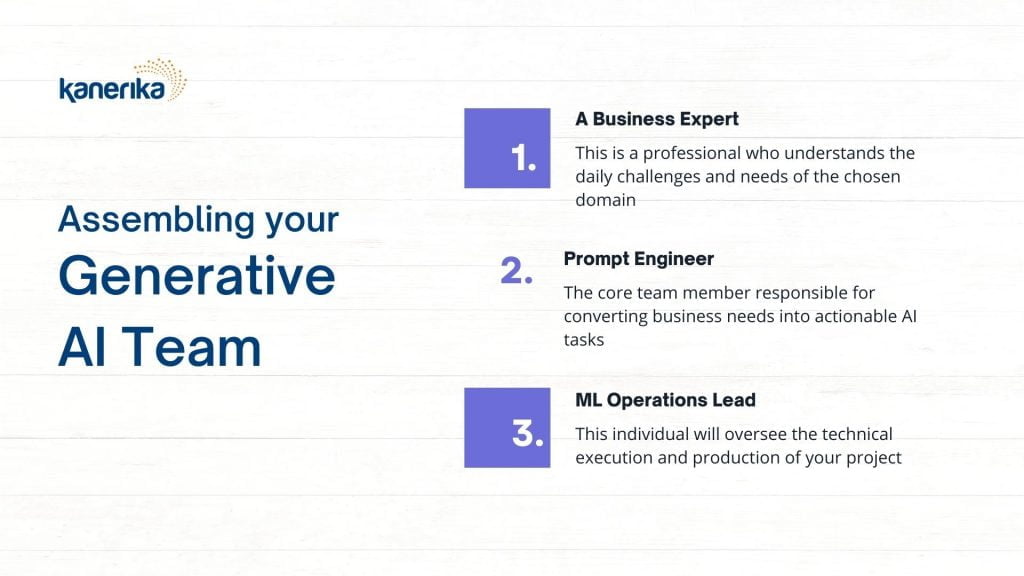
The next step in our Generative AI CTO Guide is a very important one.
Embarking on a GenAI journey requires a specialized team. This team should typically consist of three important individuals:
- A business expert who understands the daily challenges and needs of the chosen domain
- A prompt engineer responsible for converting these needs into actionable AI tasks
- A Machine Learning (ML) operations lead to oversee the technical execution and production
However, talent is often scarce.
A SnapLogic study found that 93% of organizations prioritize AI and ML, but over half lack the in-house skills and individuals for execution. This is where external partnerships can be a game-changer.
Take Kanerika, for example. With a robust team of over 300 skilled professionals in Cloud, BI, AI/ML, and generative AI, Kanerika has delivered transformative results for our global clients.
In one case, Kanerika assisted an Asian insurance provider in overcoming operational inefficiencies and compliance risks. By automating data extraction and leveraging generative AI models, Kanerika not only reduced claim processing time but also significantly increased customer satisfaction.
5. Charting the Course: Creating a Business Roadmap for Generative AI
Generative AI implementation may seem complex, but often it just requires a clear business roadmap.
Step five of our Generative AI CTO Guide is all about defining your intentions, objectives, and desired output with your GenAI model. It’s crucial to have a skilled human in the loop, especially during the initial stages, to provide oversight and ensure that the AI aligns with your business goals.
The value derived from a generative AI project can be multifaceted—direct business value, incremental gains over legacy systems, and the projected value when scaled across various use cases.
CIOs and CTOs play a pivotal role here. They are the architects who can prevent a “death of the use case” scenario, a common pitfall in many organizations. By collaborating with CEOs and CFOs, they can identify the most lucrative opportunities that GenAI can unlock.
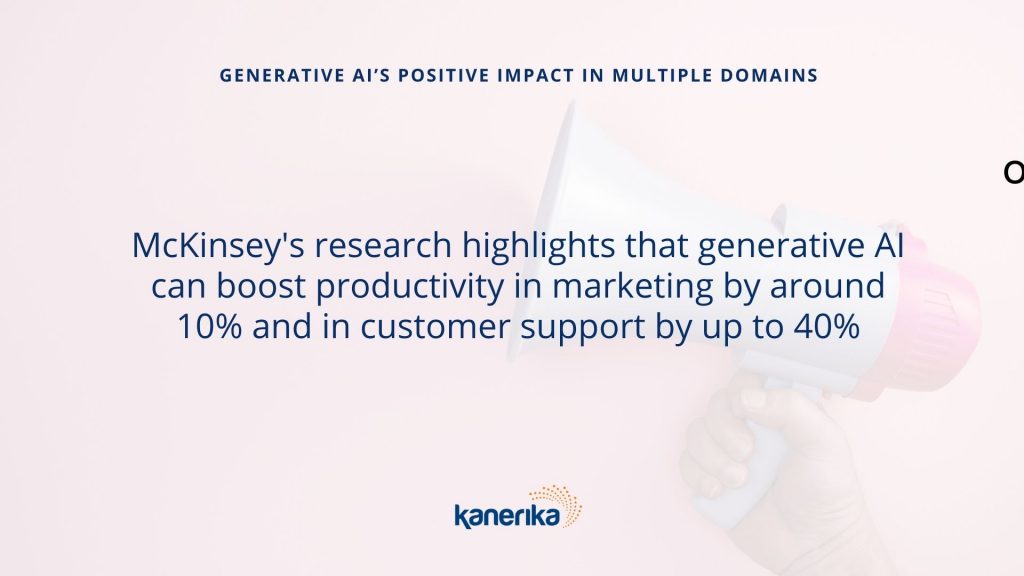
McKinsey’s research highlights that generative AI can boost productivity in marketing by around 10% and in customer support by up to 40%. Therefore, CIOs and CTOs need to work closely with their business counterparts and exchange information to identify the perfect balance between return on investment (ROI) and technological feasibility.
The perfect scenario? The business team and technology team are on the same page and agree to a balanced approach that sees them scale their company’s GenAI capabilities while balancing costs and potential changes that may arise from it.
6. Maximizing Output: The Smart Way to Utilize Generative AI
Step six of our Generative AI CTO Guide is where you roll up your sleeves. Work closely with your trio team to design the prompts that will steer the GenAI model’s responses. Leverage your team’s expertise in understanding business requirements, engineering the right prompts, and overseeing the technical execution of your AI model.
While this tri-process seems pretty successful for organizations at the moment, we may not have to depend on it for too long. The World Economic Forum has declared prompt engineering “the job of the future.”, recent advancements in generative AI models seem to clain otherwise. GenAI models such as GPT-4, have already begun creating prompts and feeding them back to users for the most optimized responses.
Clearly, just entering prompts is not the challenge that businesses seem to face today. It is problem formulation—the ability to identify, analyze, and delineate problems. This is where your team will play the most crucial role in identifying the right problems and getting the appropriate answers from your generative AI model.
It’s not just about having a smart AI; it’s about asking the right questions to get the smart answers.
7. Speak Their Language: How Generative AI Engages Your Audience
The next step in our Generative AI CTO Guide is about crafting a seamless user experience (UX) and interface (UI) for your GenAI model. Adobe’s survey shows that 62% of UX designers already use AI to automate tasks.
Your goal? Create an intuitive, responsive interface that works across devices.
Start with a selection screen allowing users to choose the tone—formal, casual, technical, or creative—for the generated content. Or, make the entire experience of communicating with the bot so seamless that it resembles a human interaction.

Source: Wendy’s
The best example of this would be the recent partnership between fast food chain, Wendy’s and Google. Together, they created a generative AI chatbot, “Wendy’s FreshAI.” The bot could take drive-thru orders by presenting an order screen to consumers, who could then speak to the bot and confirm their orders.
Why does this work?
Because the entire process is extremely easy, it resembles a typical drive-thru experience. Simultaneously, it replaces human staff with automated bots that are trained to have conversations with customers. This frees up the human staff to work around the kitchen and focus on the preparation of food and delivery.
8. The Blueprint for Success: Mastering Language Model Operations

As we approach the last step of our Generative AI CTO Guide, it’s essential to summarize what we have discussed so far. Broadly speaking, we can cover the above steps in the following processes:
- Identify the right domain and role
- Give your model the right data sources
- Create a business roadmap and identify the right team for implementation
- Design a good UI/UX for the best customer experience
And lastly, have a robust Language Model (LM) operations plan.
This is your roadmap for everything from infrastructure and continuous performance upgrades to human-in-the-loop oversight and security measures. Engage your management team with key questions about cost controls. As well as measuring impact, and avenues for continuous improvement to ensure you’re on the right path.
Let’s talk about a real-world example that hits close to home. Kanerika recently worked with a B2B SaaS company facing challenges in operational efficiency and customer support.
By implementing a Language Model-based ticket response system, Kanerika’s team of GenAI specialists helped them achieve a 70% increase in customer satisfaction, reduced staffing costs, and quicker ticket resolution times.
This case illustrates how a well-executed LM operations plan can not only solve immediate challenges but also pave the way for a company’s sustainable growth.
The Journey Ahead: Why This is Just the Start in Generative AI
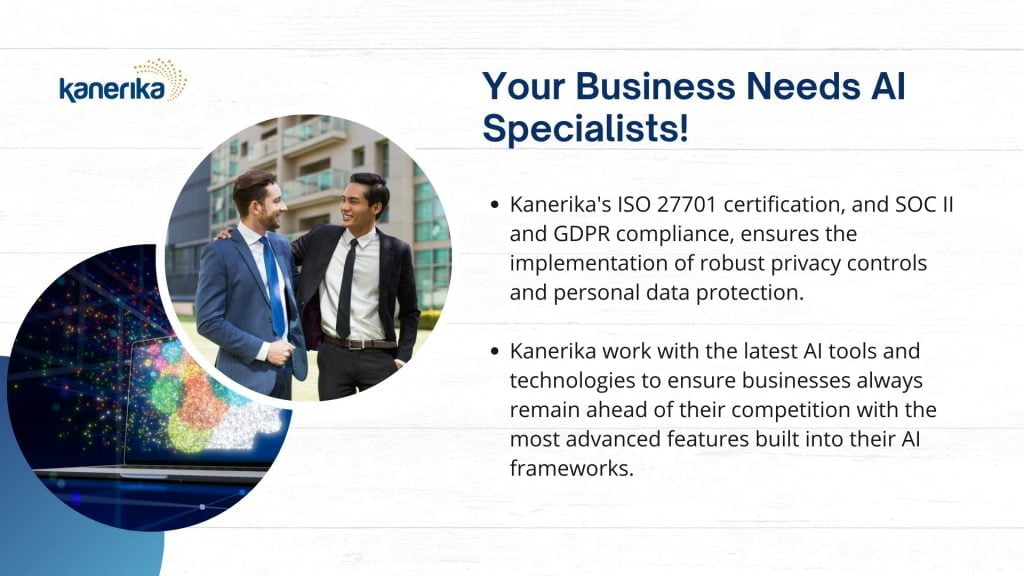
As we conclude our Generative AI Business Guide, it is important to address the elephant in the room. What does the success of your GenAI project depend on?
There are a couple of factors, but the most important metrics relevant to our discussion are the following:
- Customer satisfaction
- ROI
- Scalability of your AI functionalities
- Employee productivity
The success of your GenAI project hinges on robust KPIs that cover a spectrum of these metrics. These KPIs serve as the pulse of your project, offering insights into your AI model’s business impact.
At Kanerika, we embed these KPIs into our end-to-end solutions. Thus, ensuring that your investment in generative AI is not just innovative but also measurable, scalable, and compliant. We understand the nuances of implementing AI solutions that are both powerful and responsible. Kanerika’s ISO 27701 certification and SOC II and GDPR compliance ensure the implementation of robust privacy controls and personal data protection.
Are you looking to scale your organization’s operations? Kanerika’s team can help you identify your objectives and build the right generative AI solution for your requirements.


